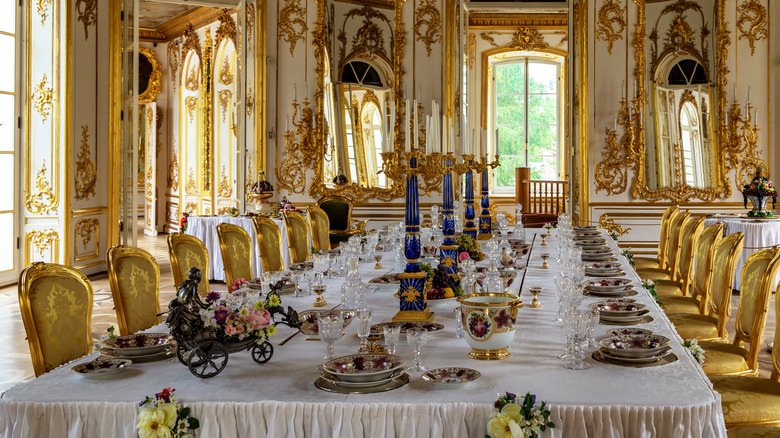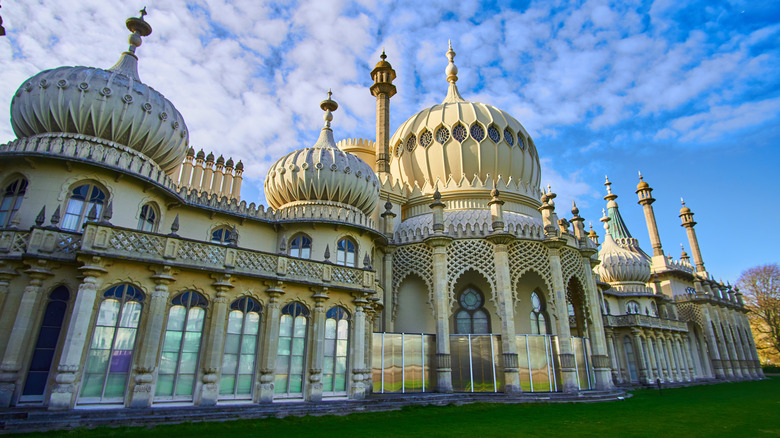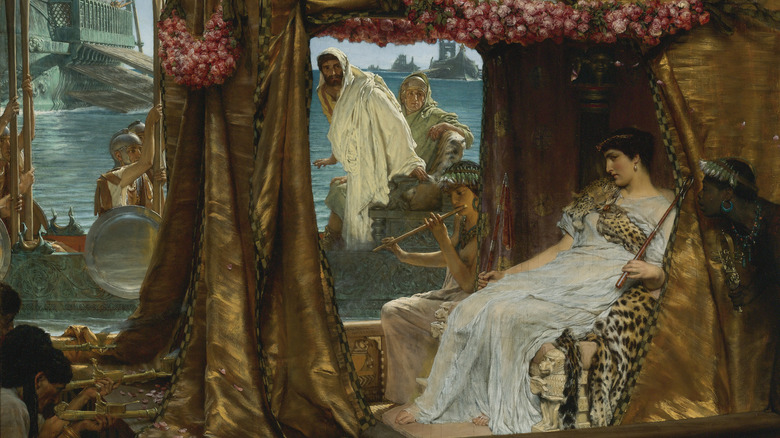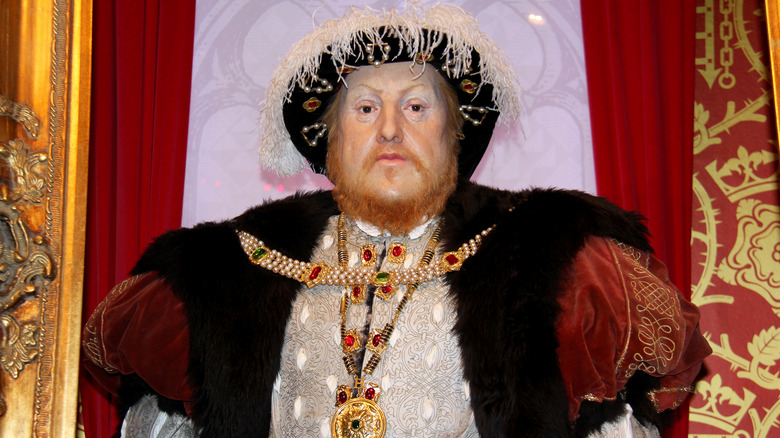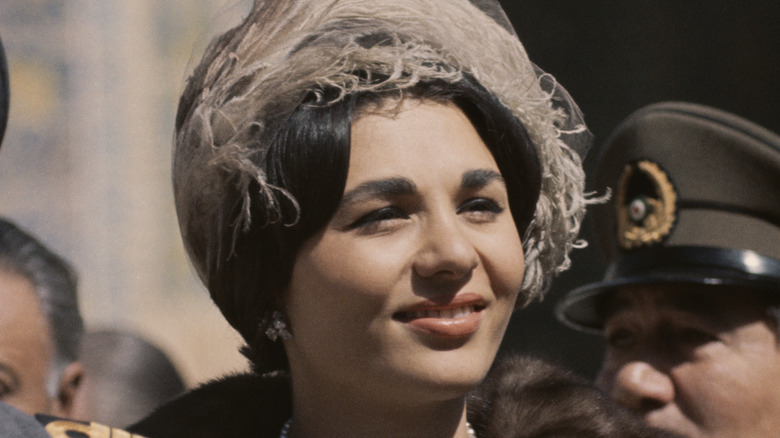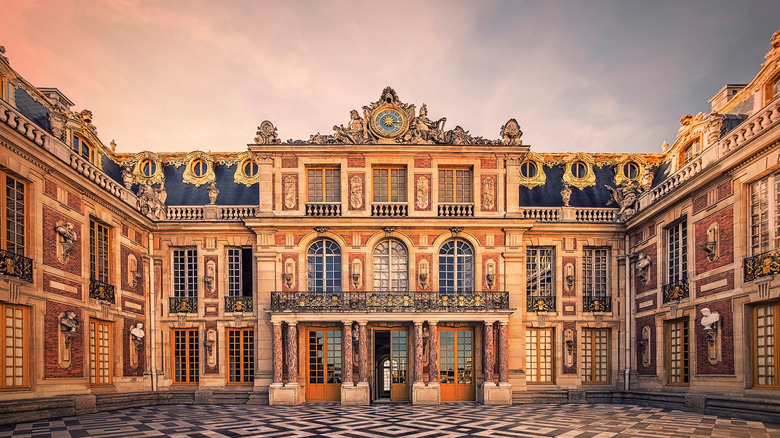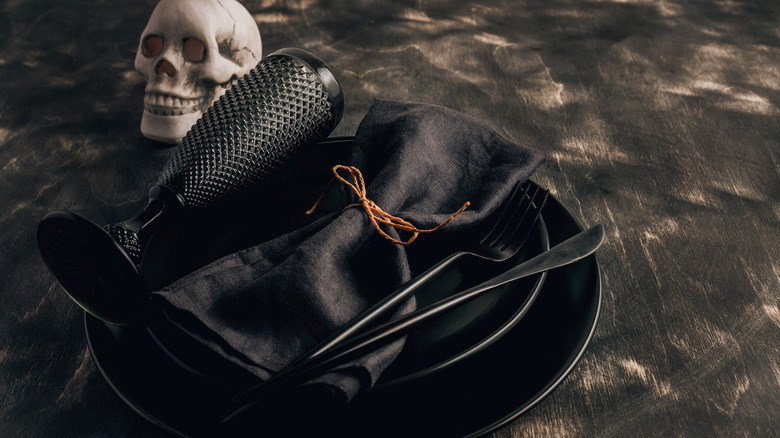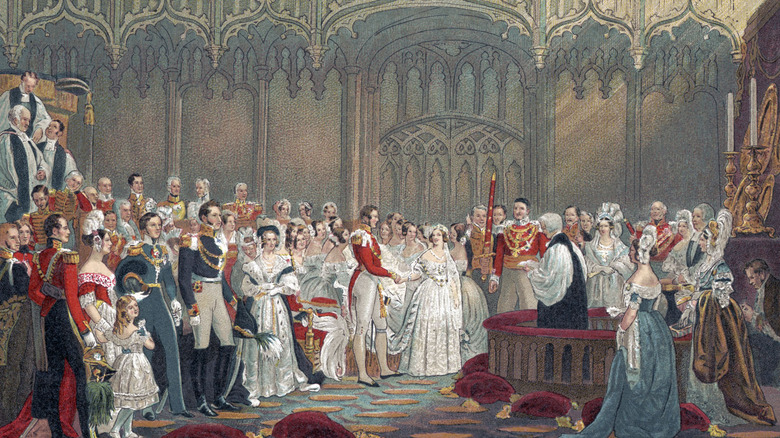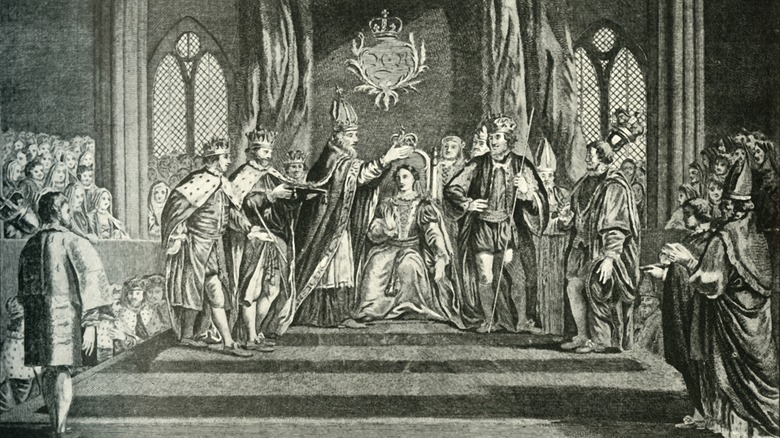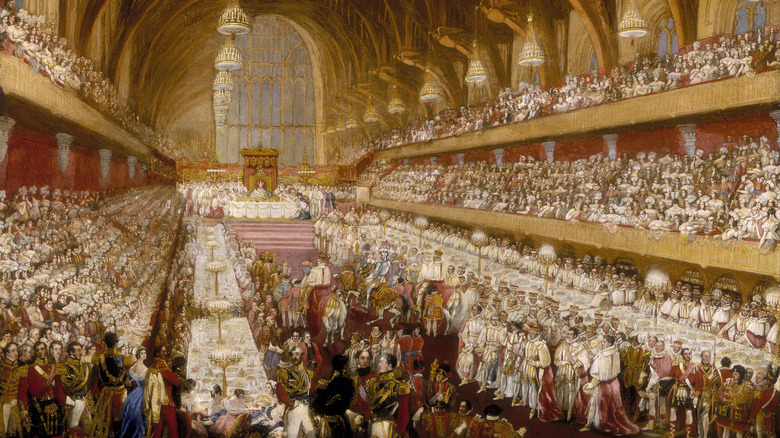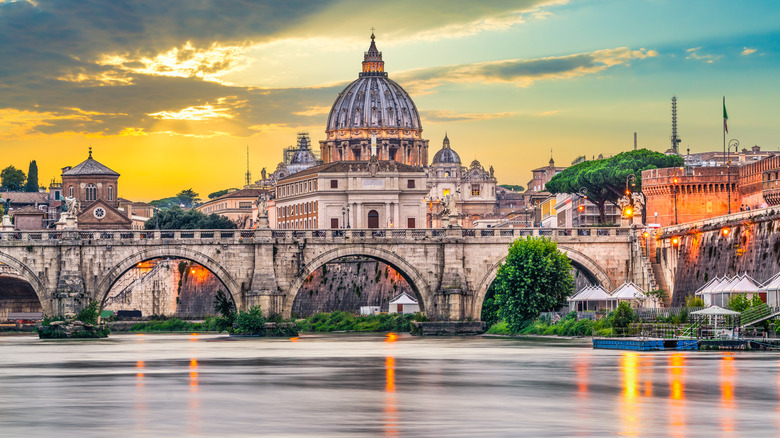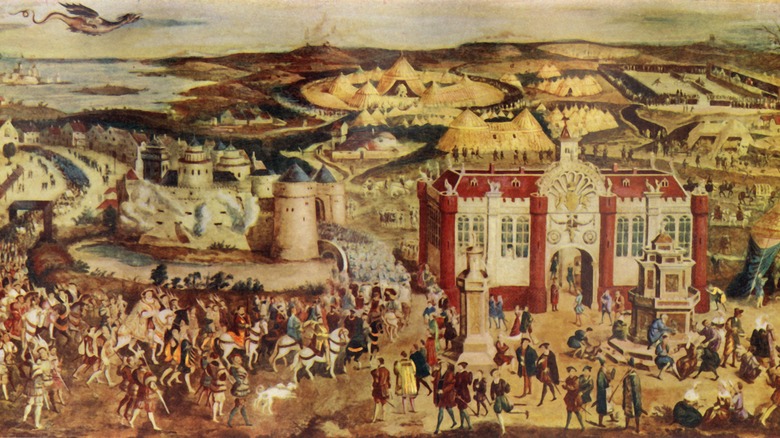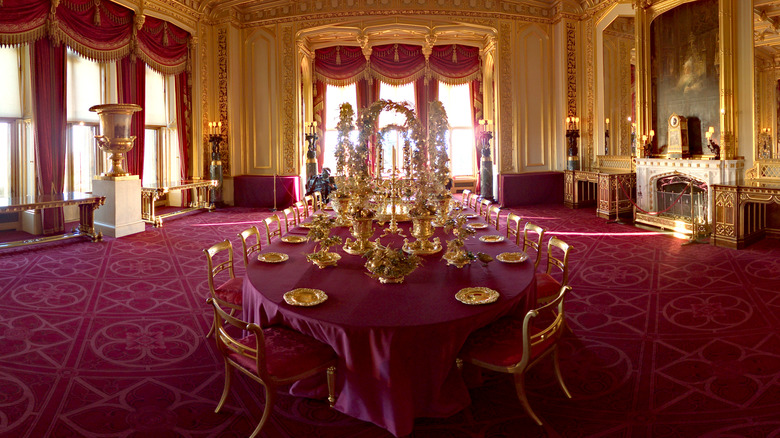The Most Lavish Royal Meals In History
Whether you're a staunch monarchist or just a casual gawker, it's hard to look away when the royals throw a major bash. Just look at the numbers: The BBC estimates that 1.9 billion viewers (yes, that's billion with a "b") tuned in to witness the wedding of Prince Harry and Meghan Markle in 2018; And History reports that an astounding 2.5 billion people watched the live broadcast of Princess Diana's funeral in 1997. But no matter how many weddings, funerals, and state dinner speeches you catch moments of, you're unlikely to be invited to the magnificent meals that follow many of these occasions. So you may be wondering just how lavish the spreads really are.
Feasting is a tradition as old as society, but no one does it quite like the ruling class. And few have had resources as seemingly unlimited as the all-powerful royals of history. The Washington Post reports that there are only around two dozen royal families currently in power. And it may be less popular in today's world to frivolously flash exorbitant wealth than it was in the past, when that kind of excess demonstrated strength and stability to citizens. Even still, not all of the most extravagant noble feasts took place centuries ago. With dates ranging from antiquity through the late 20th century, these are the most lavish royal meals in history.
The Regent's Banquet
Celebrity chefs are nothing new, and royals love them as much as the rest of us. In 1817, the future King George IV hired famed chef Marie-Antoine Carême to bring his renowned flair for dramatic cuisine to The Royal Pavilion at Brighton in honor of the future Tsar Nicolas I's visit to England. Today, it's sometimes referred to as The Regent's Banquet – at the time, George was still only prince regent and heir to the throne (and Nicolas was still just grand duke of Russia). And The Royal Pavilion & Museums reports that it was truly a sumptuous affair.
This feast for the future sovereigns boasted a spectacular menu of more than 100 dishes, including eight soups, 40 entrees, and 32 desserts. The spread featured delicacies like jellied partridge with mayonnaise, terrine of larks, and head of great sturgeon in champagne, culminating in an eye-popping replica of The Royal Pavilion made entirely of pastry. This magnificent meal served just 45 dinner guests, but it was followed by a more widely attended ball that lasted long into the night and included further breaks for refreshments — as if any could be needed after such an intense feast (via RegencyDances.org).
Cleopatra's pearl
Cleopatra was the last Pharaoh of Egypt – and the last of the royal family of Ptolemies to sit on the throne — before the Roman Empire absorbed the kingdom in 30 B.C. The legendary Egyptian queen is the subject of countless scandalous tales, ranging from murder and seduction to her own dramatic demise. Many of these stories are likely exaggerated, but if the Roman scholar, Pliny the Elder, is to be believed, Cleopatra certainly had a flair for one-upping, and proved her prowess conclusively in a single moment during a private feast.
As retold in "The Classical Journal," republished by University of Chicago, Cleopatra mocked Mark Antony's idea of indulgence, believing her husband's gluttonous consumption of rare foods to be far beneath her. She bet him she could spend 10 million Roman sesterces — estimated to be the equivalent $5 million today — on a single dinner, and would do it the following day. Cleopatra served plenty of fine foods during the meal, but nothing too different from what the pair regularly consumed. Mark Antony surely thought he had won the bet by the time dessert, a curiously meager bowl of vinegar, was served. But that's when Cleopatra removed one of her pearl earrings — believed to be a pair of the largest and most expensive pearls in the world — and dissolved it in the vinegar before casually drinking it down and, presumably, winning the bet.
Henry VIII's Christmas feasts
It would be folly to talk about royal feasts without mentioning King Henry VIII. For as many wives as he famously had, there was an even greater number of lavish Christmas feasts throughout his reign. For a little perspective on how Christmas-crazed this monarch was, consider this: BBC reports that Henry VIII spent £7,000 (roughly $8,600) per year on Christmas celebrations alone, while his father's entire annual budget for his full royal household was only £12,000 ($14,800). To be fair, a Tudor Christmas lasted 12 days (remember the song?), but this budget was still a whopper.
So what did King Henry VIII serve at these costly fêtes? Like the gifts in the Christmas carol, Henry's feasts featured an awful lot of birds, including turkeys, swans, and peacocks (via BBC). It's notable that, during this period, most of England rarely enjoyed meat, an expensive provision that was just too far out of reach for the common subject. So the sheer volume of meat served at the king's Christmas dinners was ostentatious enough, but the presentation is what really stole the show. According to historians at Hever Castle, when a magnificent bird was presented to the king at a Christmas feast, it looked less like the roasts we're used to today and more like a taxidermized centerpiece. The skin that had been carefully removed ahead of cooking was returned to the bird before it made its way to the table in full-feathered glory.
The Persepolis celebration
While the Persian royal family is no longer in official control of Iran today, the early 1970s saw a royal bash of epic proportions during the monarchy's final decade. The Royal Watcher blog reports that the festivities were among the most extravagant of the entire century. In honor of the 2,500th anniversary of the Persian Empire, Shah Mohammad Reza Pahlavi attracted the world's attention with several days of elaborate ceremonies and unveilings in Persepolis, the site of the ancient Persian capitol. But one feast in particular would come to be known as the party of the century.
On the birthday of his wife, Queen Farah, the Shah hosted an extravagant banquet, welcoming dozens of members of the world's royal families for a meal in a glittering tent city created entirely for the celebration. To enrich what was otherwise a barren desert, an artificial forest of thousands of trees, complete with 50,000 imported songbirds, was temporarily planted in Persepolis. As for the dinner itself, roughly 18 tons of food were flown in from Paris (that's 36,000 pounds, for those who don't want to do the math). History of Yesterday reports one of the tablecloths alone took six months and 135 women to complete. In the end, the unrivaled event was lauded as the most expensive party of modern history, and was certainly the most royally attended.
The Great Royal Entertainment
Among the egos of historic European royalty, few are as famous as that of King Louis XIV of France, who famously declared "I am the state," and dubbed himself the Sun King — you know, that golden ball of life-giving energy around which the entire world revolves. Today, French culture is widely viewed as refined and elegant largely because of King Louis' persistent efforts to glorify his reputation through his opulent Palace of Versailles and the court he cultivated there. Before Versailles became the sprawling seat of the monarch, though, Louis XIV's humble hunting grounds staged what Château de Versailles today calls "the height of Baroque celebrations" — The Great Royal Entertainment.
This single day of revelry to celebrate victory over Spain swallowed one third of Versailles' entire annual budget. The festivities included: a magnificent feast hosted in a massive hall erected specifically for the occasion; a sumptuous afternoon tea with heaps of fruits and meats; a premiere musical performance from Molière in an elaborate theater hung with 32 crystal chandeliers; a formal ball in yet another temporary hall that, despite its transient nature, was still covered in marble and porphyry, with no expense spared on decor; and finally, a fireworks display to end the party with a literal bang.
The Black Banquet
Ancient Roman emperors didn't use the title "king," but they were considered as royal as it gets. So it's fitting that at least one of them appears on this list. Emperor Domitian's Black Banquet was lavish indeed, but what makes this meal so notable is how terrified guests were from the moment they arrived until after they returned home (via JSTOR Daily).
As NPR reports, Domitian may have successfully rebuilt Rome after decades of decline and disaster, but he was as renowned for his cruelty as he was for his restoration. It would seem not even his friends rested easy in this tumultuous and fickle atmosphere. At a time when enemies and criminals were routinely and publicly slaughtered, imagine the instant pang of fear Domitian's guests must have felt when they arrived at a banquet hall outfitted entirely in black marble and drapery (via The Smart Set). At the black table, place settings were marked with actual gravestones bearing the guests' names. The food, all dyed black and presented on gleaming black onyx plates, was served by naked waiters painted entirely black, of course. After the tense meal, guests were escorted out on litters hoisted by Domitian's guard, reasonably assuming they were being carried to their own executions. Instead, they were each taken home and given expensive gift bags to commemorate the meal. To this day, no one knows for sure why Domitian hosted this creepy and conspicuous feast.
Queen Victoria's wedding feast
Queen Victoria was only 20 years old when she was to be married, and her young husband-to-be was a poor prince who inspired little in her subjects. As Australia's Special Broadcasting Service reports, Victoria was determined to change public opinion about her seemingly unimpressive match with an over-the-top wedding that would display enough strength and power to silence dissenters. Though it's also worth noting that other reports claim her big wedding was purely a political decision inspired by the prime minister, as the queen would have preferred a quiet affair (via Vogue).
Queen Victoria's big day saw the bride in a white couture gown with intricate lace and embroidery. And in fact, the attention lavished on this single wedding is actually a big reason it's popular for brides to wear white today (via Vanity Fair). After the queen arrived at her ceremony in a golden carriage, the feast that followed was certainly elaborate. But the menu may not sit as well with modern guests as it did in 1840. It featured dishes like broiled fish and pigeon pie, complete with feet protruding from the center. Regardless, it's the cake that is most remembered. Measuring nearly 9 feet in diameter and weighing in at almost 300 pounds, it would probably be just as enthralling to guests today as it was then (via SBS).
The coronation feast for Anne Boleyn
Anne Boleyn may have considered herself inordinately lucky to have bested Catherine of Aragon and stolen her husband, Henry VIII. But history would prove this to be a devastating path for Boleyn, who was beheaded just three years after becoming the new queen. Still, we'll cautiously use the word "lucky" one more time in reference to Boleyn when discussing her coronation, if only because she was the last of Henry's many wives to even receive one (via Royal Central).
As told by 16th-century chronicler Edward Hall, the entire affair was dripping in gold, silver, and velvet (via English History). Ermine-adorned guests watched as Boleyn was chauffeured from venue to venue, surrounded by the country's nobility. At the epic feast that followed the ceremony, Tudor Times reports that close to 100 dishes were served to the newly anointed queen. Her first course alone included 32 dishes, and the following two brought an additional 54 dishes for the queen to enjoy. But it's worth noting that not all her guests got to partake in a feast of this magnitude — the number of plates served to each person decreased according to their rank.
King George IV's coronation banquet
This is the second feast from George IV to make the list of most lavish royal meals — but don't expect it to be the last for this monarch. King George IV was known less for his service to England than for his indulgence in his own passions — and that included food. In fact, The Guardian even puts him on their list of history's famous foodies.
For his coronation in 1821, George IV spent a year and half planning a single dinner that cost the equivalent of roughly $25 million today (per The Daily Express). And it was no financial oversight — George was about to inherit the crown of the world's richest nation, and he wanted a coronation even more splendid than Napoleon's to demonstrate this. The royal banquet fed nearly 2,500 guests throughout the Palace of Westminster. The menu included venison, veal, mutton, beef, braised ham, goose, lobster, crayfish, and plenty more, all washed down with 9,000 bottles of wine.
The Banquet of Chestnuts
Whether you consider the Catholic Church a religious or political organization, the head of the church, the pope, is recognized as the world's last remaining absolute monarch. The Catholic Church is no stranger to extreme displays of wealth, and one of history's most infamous feasts came from one the church's most storied families, the Borgias.
The Banquet of Chestnuts has gone down in history as not just one of the most lavish, but also one of the most scandalous (via Ancient Origins). It was hosted by Pope Alexander VI's disreputable son, Cesare Borgia. Details of the banquet come from the diary of Johann Burchard, the master of ceremonies for the pope at the time (via History of Yesterday). He wrote that the guest list included 50 high-class courtesans who, after the meal, were tasked with bending over to collect a sea of chestnuts strewn about the floor. The goal for the remaining, noble guests (including the Pope himself) was to go to bed with as many of these woman as possible, and prizes were awarded to the champions. It's worth noting that many historians suspect the details about this sordid affair have been exaggerated in an attempt to make the church look bad.
The Field of Cloth of Gold
Several of the most lavish royal feasts in history were the result of weddings, coronations, and holidays, but this one is a little different. The Field of Cloth of Gold, as it would come to be known, supposedly celebrated friendship. Okay, that may be downplaying the situation a little; Smithsonian Magazine reports that England's Henry VIII and France's Francis I turned the event into more of a competitive exhibition of wealth and power rather than a proclamation of lasting peace. The exorbitantly expensive festival was essentially an outlet for the two young monarchs to diplomatically one-up each other in friendly rivalry.
The Field of Cloth of Gold, as its name suggests, was outfitted with endless yards of gold-embellished fabric in the form of costumes, tents, and decorations. Thousands of nobles gathered for more than two weeks as the kings continuously demonstrated their boundless resources through ceremonies and competitions. Ironically, in an effort to display their diplomatic partnership, the kings were careful not to outrank one another, competing on the same side of tournaments and dining at each other's courts for lavish feasts. More than a million planks of wood were required to heat the ovens to prepare these extravagant meals, which boasted around 50 dishes each. Entire herds of deer and sheep were imported to feed the two kings' guests. As for the monarchs themselves, they ate off gold plates served alongside Venetian glass and actual silver spoons.
The Grand Fête
Arguably topping all other monarchs when it comes to royal feasts, super-indulger George IV threw such a magnificent fête after his ascension to regency in 1811, it still influences many British state functions today. Unfortunately for George, his regency came at the expense of his father's mental illness, making a self-congratulatory celebration something of a distasteful occasion. So this feast was advertised as a birthday party for his father, though the true intention has been the subject of speculation (via RegencyHistory.net).
Regardless of the occasion, the Georgian Era blog reports that everything at the Grand Fête, from attire to table design, was over the top — including a fresh stream running down the prince's table, complete with live fish and flowering banks. But it's the table service that has never been topped. The dazzling dinnerware collection, known as the Grand Service, includes more than 4,000 pieces of gilded silver, according to The Royal Collection Trust. It is so beloved by British royalty that it remains in use today for state banquets at Buckingham Palace and Windsor Castle.
